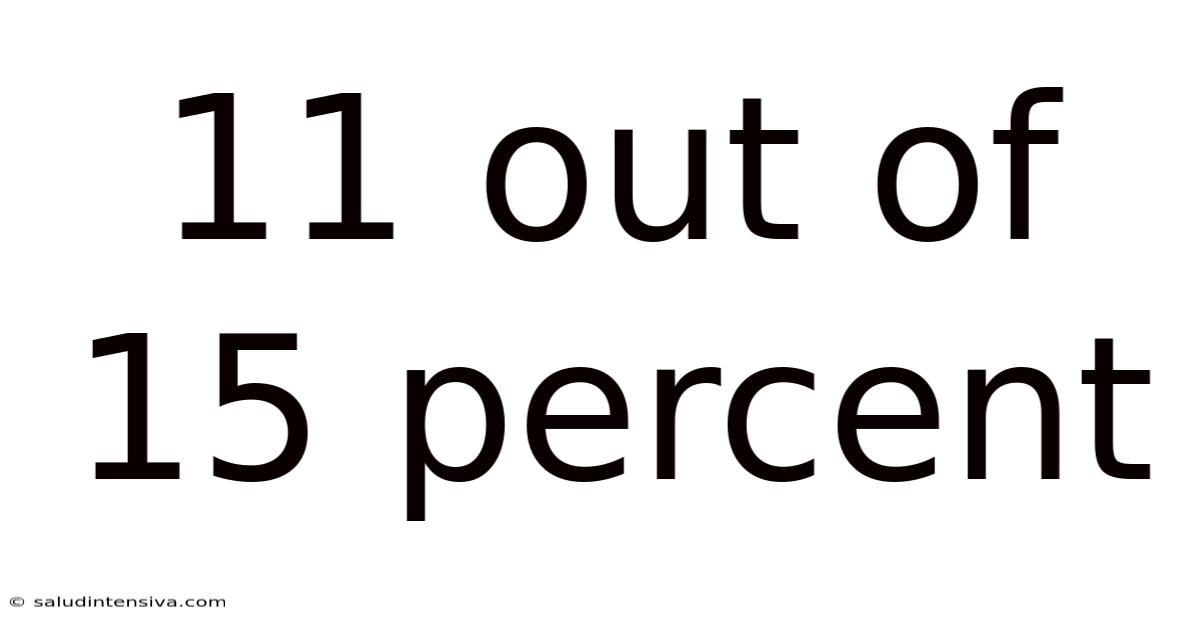11 Out Of 15 Percent
saludintensiva
Sep 14, 2025 · 4 min read

Table of Contents
Understanding 11 out of 15: Fractions, Percentages, and Real-World Applications
Understanding how to express parts of a whole is a fundamental skill in mathematics, crucial for navigating everyday life and excelling in various fields. This article delves into the concept of "11 out of 15," explaining its representation as a fraction, percentage, and decimal, along with its applications in diverse real-world scenarios. We'll also explore related concepts and address common misconceptions to provide a comprehensive understanding of this seemingly simple yet versatile mathematical idea.
Representing 11 out of 15
The phrase "11 out of 15" signifies a part-to-whole relationship. It indicates that 11 units represent a portion of a total of 15 units. This can be expressed in several ways:
-
Fraction: The most direct representation is as a fraction: 11/15. This fraction is in its simplest form, meaning there's no common divisor (other than 1) that can simplify the numerator (11) and the denominator (15).
-
Percentage: To convert the fraction to a percentage, we divide the numerator by the denominator and multiply by 100: (11/15) * 100 ≈ 73.33%. This means 11 out of 15 represents approximately 73.33% of the whole.
-
Decimal: The decimal equivalent of 11/15 is obtained by performing the division: 11 ÷ 15 ≈ 0.7333. This is an example of a repeating decimal, where the digit 3 repeats infinitely. For practical purposes, rounding is often necessary.
Real-World Applications of 11/15
The concept of 11 out of 15 finds practical applications in numerous real-world situations. Here are some examples:
-
Academic Performance: Imagine a student who answered 11 questions correctly out of a total of 15 questions on a quiz. Their score would be 11/15, or approximately 73.33%. This helps assess their understanding of the subject matter.
-
Manufacturing Quality Control: In a factory producing 15 units of a product, if 11 pass quality checks, the success rate would be 11/15 or 73.33%. This helps track production efficiency and identify potential issues.
-
Sports Statistics: A basketball player making 11 out of 15 free throws has a field goal percentage of 73.33%. This metric provides insight into their shooting accuracy.
-
Survey Results: If 11 out of 15 respondents in a survey agree with a particular statement, the percentage of agreement would be 73.33%. This is crucial in analyzing public opinion and consumer preferences.
-
Project Completion: A project consisting of 15 tasks, with 11 completed successfully, reflects a 73.33% completion rate. This is useful in tracking project progress and identifying potential delays.
-
Financial Investments: If an investor invests in 15 different stocks, and 11 of them show positive returns, the success rate of their investment strategy is 73.33%. This is valuable in portfolio performance analysis.
Extending the Understanding: Working with Fractions and Percentages
Understanding "11 out of 15" provides a springboard to explore related mathematical concepts:
-
Comparing Fractions: It's often necessary to compare fractions. For example, is 11/15 greater than or less than 2/3? To compare, we can find a common denominator (in this case, 15) and rewrite 2/3 as 10/15. Since 11/15 > 10/15, we conclude that 11/15 is greater than 2/3.
-
Adding and Subtracting Fractions: Operations with fractions require a common denominator. For instance, adding 11/15 and 2/5 (rewritten as 6/15) results in (11+6)/15 = 17/15, or 1 and 2/15.
-
Multiplying and Dividing Fractions: Multiplication involves multiplying the numerators and denominators separately. Division involves inverting the second fraction and multiplying.
-
Converting Between Fractions, Percentages, and Decimals: The ability to seamlessly convert between these representations is critical for practical applications. Remember that a percentage is a fraction with a denominator of 100, and a decimal is a representation using powers of 10.
Addressing Common Misconceptions
Several misconceptions often surround fractions and percentages:
-
Treating percentages as absolute values: A 73.33% success rate doesn't mean 73.33 units out of 100; it represents the proportion of success relative to the total.
-
Incorrect rounding: Rounding percentages or decimals should be done appropriately based on the context and required level of precision. Rounding 73.33% to 73% might be acceptable in some cases but not in others.
-
Difficulty with complex fractions: Understanding how to simplify complex fractions and perform operations on them is vital for more advanced mathematical problems.
Further Exploration and Practice
To solidify your understanding of "11 out of 15" and related concepts, engage in these activities:
-
Practice problems: Solve various problems involving fractions, percentages, and decimals, focusing on conversion and operations.
-
Real-world applications: Look for opportunities to apply these concepts in everyday life, such as calculating discounts, analyzing data, or evaluating probabilities.
-
Explore advanced concepts: Delve deeper into topics like ratios, proportions, and statistical analysis, where fractions and percentages are fundamental components.
Conclusion
Understanding "11 out of 15" goes beyond simply knowing its numerical value. It's about grasping the underlying concept of representing parts of a whole and the ability to express that relationship in different forms – fractions, percentages, and decimals. This knowledge is essential for navigating everyday life, tackling mathematical problems, and understanding data in various fields. By mastering this fundamental concept and related mathematical skills, you'll equip yourself with powerful tools for effective problem-solving and decision-making. Continue practicing and exploring these concepts to build a strong foundation in mathematics.
Latest Posts
Latest Posts
-
7 Out Of 20 Percentage
Sep 14, 2025
-
1 2 To The Fourth Power
Sep 14, 2025
-
2 3 4 Divided By 3
Sep 14, 2025
-
What Percentage Is 15 20
Sep 14, 2025
-
Convert Mm To Sq Feet
Sep 14, 2025
Related Post
Thank you for visiting our website which covers about 11 Out Of 15 Percent . We hope the information provided has been useful to you. Feel free to contact us if you have any questions or need further assistance. See you next time and don't miss to bookmark.